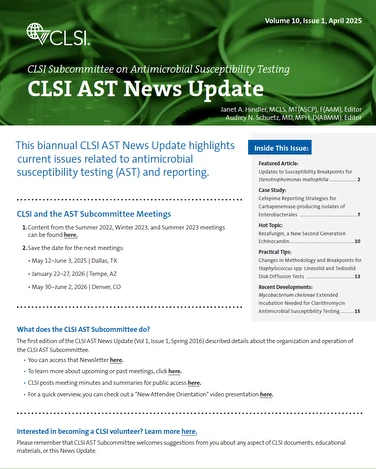You'll receive the latest updates on new standards, guidelines, and educational resources, as well as expert insights to help enhance your laboratory's performance and compliance.
Cefepime Reporting Strategies for Carbapenemase-producing Isolates of Enterobacterales
Rebekah Dumm, Washington University School of Medicine, St. Louis, MS
Romney M. Humphries, Vanderbilt University Medical Center, Nashville, TN

Rebekah Dumm, Washington University School of Medicine, St. Louis, MS
Romney M. Humphries, Vanderbilt University Medical Center, Nashville, TN
CLSI AST News Update | Volume 10, Issue 1, April 2025
Clinical Case
A 34-year-old patient with quadriplegia was admitted with tachypnea and fever. A diagnostic evaluation for pneumonia was performed, including a molecular pneumonia panel and respiratory cultures on expectorated sputum. The molecular pneumonia panel detected Klebsiella oxytoca and blaKPC. In response to these results, the patient was started on ceftazidime-avibactam. Respiratory cultures revealed heavy growth of K. oxytoca and normal flora the following day. Results of antimicrobial susceptibility testing (AST) for the K. oxytoca are shown in Table 1.

Test Results Assessment and Troubleshooting
AST results for ceftriaxone, ceftazidime, meropenem and imipenem (all resistant) were consistent with the blaKPC gene detected by the molecular panel. However, the cefepime MIC of 2 μg/mL (S), was unexpected for a carbapenemase-producing isolate. This result could be due to testing errors or a true phenotype, so troubleshooting was performed.
Purity plates were re-examined, which showed no evidence of a mixed culture. Next, a phenotypic test for carbapenemase production (CarbaNP) was performed on the K. oxytoca isolate. This test was positive, indicating active expression of the blaKPC gene. A disk diffusion test was also performed for cefepime, to rule out random error in the original AST; this revealed a susceptible zone of growth inhibition. Together, these suggested no testing errors had occurred.
CLSI M100 Appendix G, Table G3 provides the following guidance for cefepime susceptible or susceptible dose-dependent carbapenemase-producing isolates of Enterobacterales6:
1. Suppress the cefepime result, or
2. Report cefepime as resistant.
These options had been discussed previously with the hospital antimicrobial stewardship team. Since the blaKPC gene was endemic in the local population, the stewardship team had decided the safest course of action after laboratory troubleshooting was to report cefepime as resistant. In keeping with this policy, the laboratory released the final report in Table 2.
Discussion Points
Approximately 15% and 30% of KPC-producing Enterobacterales isolates test susceptible or susceptible dose-dependent to cefepime, despite carbapenem resistance.1,2 In 2021, CLSI M100, CLSI broadly recommended phenotypic and genotypic tests be repeated for cases where a carbapenemase target was detected but third or fourth generation cephalosporins tested as S or SDD (Table 3).3 In 2024, CLSI M100, additional guidance was provided for cefepime because of the frequency of cefepime susceptible MICs in carbapenem-resistant isolates.4 Animal model data on the efficacy of cefepime in carbapenemase-producing and non-carbapenemase-producing Enterobacterales with a range of cefepime MICs were presented to CLSI in 2023.7 These data showed 1-log bacterial reduction was not possible for carbapenemase (including KPC)-producing Enterobacterales treated with cefepime, even if cefepime MIC was ≤2 μg/mL. In contrast, non-carbapenemase producing carbapenem-resistant isolates achieved bacterial killing in this model, if cefepime MICs were S or SDD. These data indicated that cefepime should be avoided for treatment of serious infections caused by Enterobacterales isolates with known carbapenemase activity.7 These data supported current cefepime breakpoints and confirmed that cefepime should not be reported as susceptible for carbapenemase-producing Enterobacterales. It must be highlighted that most of these data are based on studies investigating KPC-producing Enterobacterales in animal models alone.

References
- Fissel JA, Yarbrough ML, Tekle T, Burnham CAD, Simner PJ. Reporting considerations for cefepime-susceptible and -susceptible-dose dependent results for carbapenemase-producing Enterobacterales. J Clin Microbiol. 2020;58(9):10.1128/jcm.01271-20. doi:10.1128/jcm.01271-20.
- Golden AR, Baxter MR, Karlowsky JA, et al. Activity of cefepime/taniborbactam and comparators against whole genome sequenced ertapenem-non-susceptible Enterobacterales clinical isolates: CANWARD 2007–19. JAC-Antimicrob Resist. 2022;4(1):dlab197. doi:10.1093/jacamr/dlab197.
- CLSI. Performance Standards for Antimicrobial Susceptibility Testing. 31st ed. CLSI supplement M100. Wayne, PA: Clinical and Laboratory Standards Institute; 2021.
- CLSI. Performance Standards for Antimicrobial Susceptibility Testing. 32nd ed. CLSI supplement M100. Wayne, PA: Clinical and Laboratory Standards Institute; 2022.
- CLSI. Performance Standards for Antimicrobial Susceptibility Testing. 33rd ed. CLSI supplement M100. Wayne, PA: Clinical and Laboratory Standards Institute; 2023.
- CLSI. Performance Standards for Antimicrobial Susceptibility Testing. 34th ed. CLSI supplement M100. Wayne, PA: Clinical and Laboratory Standards Institute; 2024.
- Fouad A, Gill CM, Simner PJ, Nicolau DP, Asempa TE. Cefepime in vivo activity against carbapenem-resistant Enterobacterales that test as cefepime susceptible or susceptible-dose dependent in vitro: implications for clinical microbiology laboratory and clinicians. J Antimicrob Chemother. 2023;78(9):2242-2253. doi:10.1093/jac/dkad229